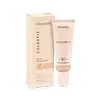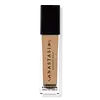What's inside
What's inside
 Key Ingredients
Key Ingredients

 Benefits
Benefits

 Concerns
Concerns

 Ingredients Side-by-side
Ingredients Side-by-side

Water
Skin ConditioningCyclopentasiloxane
EmollientIsododecane
EmollientMethyl Methacrylate Crosspolymer
Dimethicone
EmollientEthylhexyl Methoxycinnamate
UV AbsorberCaprylyl Methicone
Skin ConditioningTrimethylsiloxysilicate
EmollientButylene Glycol
HumectantPEG-9 Polydimethylsiloxyethyl Dimethicone
EmulsifyingTitanium Dioxide
Cosmetic ColorantDicaprylyl Carbonate
EmollientHydrogenated Polyisobutene
EmollientSodium Chloride
MaskingPhenoxyethanol
PreservativePentylene Glycol
Skin ConditioningTocopheryl Acetate
AntioxidantTriethoxycaprylylsilane
Divinyldimethicone/Dimethicone Crosspolymer
Skin ConditioningHydrated Silica
AbrasiveSilica
AbrasiveDisteardimonium Hectorite
StabilisingAluminum Hydroxide
EmollientPropylene Carbonate
SolventBHT
AntioxidantEthylhexylglycerin
Skin ConditioningHydrogenated Lecithin
EmulsifyingCyclotetrasiloxane
EmollientGlycerin
HumectantCaprylic/Capric Triglyceride
MaskingCentella Asiatica Extract
CleansingCholesterol
EmollientCI 77491
Cosmetic ColorantCI 77492
Cosmetic ColorantCI 77499
Cosmetic ColorantCI 77891
Cosmetic ColorantWater, Cyclopentasiloxane, Isododecane, Methyl Methacrylate Crosspolymer, Dimethicone, Ethylhexyl Methoxycinnamate, Caprylyl Methicone, Trimethylsiloxysilicate, Butylene Glycol, PEG-9 Polydimethylsiloxyethyl Dimethicone, Titanium Dioxide, Dicaprylyl Carbonate, Hydrogenated Polyisobutene, Sodium Chloride, Phenoxyethanol, Pentylene Glycol, Tocopheryl Acetate, Triethoxycaprylylsilane, Divinyldimethicone/Dimethicone Crosspolymer, Hydrated Silica, Silica, Disteardimonium Hectorite, Aluminum Hydroxide, Propylene Carbonate, BHT, Ethylhexylglycerin, Hydrogenated Lecithin, Cyclotetrasiloxane, Glycerin, Caprylic/Capric Triglyceride, Centella Asiatica Extract, Cholesterol, CI 77491, CI 77492, CI 77499, CI 77891
Water
Skin ConditioningCyclopentasiloxane
EmollientIsododecane
EmollientCaprylyl Methicone
Skin ConditioningC12-15 Alkyl Benzoate
AntimicrobialEthylhexyl Palmitate
EmollientPolyglyceryl-4 Isostearate
EmulsifyingHexyl Laurate
EmollientCetyl PEG/PPG-10/1 Dimethicone
EmulsifyingGlycerin
HumectantTrimethylsiloxysilicate
EmollientButylene Glycol
HumectantVinyl Dimethicone/Methicone Silsesquioxane Crosspolymer
Sodium Chloride
MaskingLaminaria Ochroleuca Extract
Skin ConditioningAlanine
MaskingArginine
MaskingGlycine
BufferingIsoleucine
Skin ConditioningHistidine
HumectantPhenylalanine
MaskingProline
Skin ConditioningThreonine
Serine
MaskingAspartic Acid
MaskingValine
MaskingSodium PCA
HumectantPanthenol
Skin ConditioningTocopheryl Acetate
AntioxidantAllantoin
Skin ConditioningSodium Lactate
BufferingPCA
HumectantEthylhexylglycerin
Skin ConditioningCaprylic/Capric Triglyceride
MaskingSimethicone
EmollientTetrasodium EDTA
Triethoxycaprylylsilane
Zinc Stearate
Cosmetic ColorantLauryl PEG-9 Polydimethylsiloxyethyl Dimethicone
Skin ConditioningStearalkonium Hectorite
Gel FormingPropylene Carbonate
SolventPhenoxyethanol
PreservativeChromium Oxide Greens
CI 77007
Cosmetic ColorantIron Oxides
CI 77891
Cosmetic ColorantWater, Cyclopentasiloxane, Isododecane, Caprylyl Methicone, C12-15 Alkyl Benzoate, Ethylhexyl Palmitate, Polyglyceryl-4 Isostearate, Hexyl Laurate, Cetyl PEG/PPG-10/1 Dimethicone, Glycerin, Trimethylsiloxysilicate, Butylene Glycol, Vinyl Dimethicone/Methicone Silsesquioxane Crosspolymer, Sodium Chloride, Laminaria Ochroleuca Extract, Alanine, Arginine, Glycine, Isoleucine, Histidine, Phenylalanine, Proline, Threonine, Serine, Aspartic Acid, Valine, Sodium PCA, Panthenol, Tocopheryl Acetate, Allantoin, Sodium Lactate, PCA, Ethylhexylglycerin, Caprylic/Capric Triglyceride, Simethicone, Tetrasodium EDTA, Triethoxycaprylylsilane, Zinc Stearate, Lauryl PEG-9 Polydimethylsiloxyethyl Dimethicone, Stearalkonium Hectorite, Propylene Carbonate, Phenoxyethanol, Chromium Oxide Greens, CI 77007, Iron Oxides, CI 77891
 Reviews
Reviews

Ingredients Explained
These ingredients are found in both products.
Ingredients higher up in an ingredient list are typically present in a larger amount.
Butylene Glycol (or BG) is used within cosmetic products for a few different reasons:
Overall, Butylene Glycol is a safe and well-rounded ingredient that works well with other ingredients.
Though this ingredient works well with most skin types, some people with sensitive skin may experience a reaction such as allergic rashes, closed comedones, or itchiness.
Learn more about Butylene GlycolThis ingredient is an emollient, solvent, and texture enhancer. It is considered a skin-softener by helping the skin prevent moisture loss.
It helps thicken a product's formula and makes it easier to spread by dissolving clumping compounds.
Caprylic Triglyceride is made by combining glycerin with coconut oil, forming a clear liquid.
While there is an assumption Caprylic Triglyceride can clog pores due to it being derived from coconut oil, there is no research supporting this.
Learn more about Caprylic/Capric TriglycerideCaprylyl Methicone is a type of silicone.
It helps soften and soothe the skin by creating a thin film on top. This film helps trap moisture, keeping your skin hydrated.
Ci 77891 is a white pigment from Titanium dioxide. It is naturally found in minerals such as rutile and ilmenite.
It's main function is to add a white color to cosmetics. It can also be mixed with other colors to create different shades.
Ci 77891 is commonly found in sunscreens due to its ability to block UV rays.
Learn more about CI 77891Cyclopentasiloxane, or D5, is a silicone used to improve texture of products and trap moisture.
D5 is considered lightweight and volatile. Volatile means it evaporates quickly after application. Once evaporated, D5 leaves a thin barrier that helps keep skin hydrated.
It is also an emollient. Emollients help soften the skin and prevent water loss. Silicones create a silky texture in products. D5 helps other ingredients become more spreadable.
Studies show D5 is safe to use in skincare products. We recommend speaking with a skincare professional if you have concerns.
Learn more about CyclopentasiloxaneEthylhexylglycerin (we can't pronounce this either) is commonly used as a preservative and skin softener. It is derived from glyceryl.
You might see Ethylhexylglycerin often paired with other preservatives such as phenoxyethanol. Ethylhexylglycerin has been found to increase the effectiveness of these other preservatives.
Glycerin is already naturally found in your skin. It helps moisturize and protect your skin.
A study from 2016 found glycerin to be more effective as a humectant than AHAs and hyaluronic acid.
As a humectant, it helps the skin stay hydrated by pulling moisture to your skin. The low molecular weight of glycerin allows it to pull moisture into the deeper layers of your skin.
Hydrated skin improves your skin barrier; Your skin barrier helps protect against irritants and bacteria.
Glycerin has also been found to have antimicrobial and antiviral properties. Due to these properties, glycerin is often used in wound and burn treatments.
In cosmetics, glycerin is usually derived from plants such as soybean or palm. However, it can also be sourced from animals, such as tallow or animal fat.
This ingredient is organic, colorless, odorless, and non-toxic.
Glycerin is the name for this ingredient in American English. British English uses Glycerol/Glycerine.
Learn more about GlycerinIsododecane is a fragrance, emollient, and solvent.
As an emollient, it helps your skin stay soft and hydrated. Emollients help trap moisture into your skin.
Isododecane's role as a solvent makes it a great texture enhancer. It spreads smoothly on skin and does not leave a sticky feeling behind. Isododecane also helps prevent color transfer in makeup products.
Isododecane is not absorbed into skin.
Learn more about IsododecanePhenoxyethanol is a preservative that has germicide, antimicrobial, and aromatic properties. Studies show that phenoxyethanol can prevent microbial growth. By itself, it has a scent that is similar to that of a rose.
It's often used in formulations along with Caprylyl Glycol to preserve the shelf life of products.
This ingredient is a solvent. It helps dissolve active ingredients and alter the texture of products.
Propylene Carbonate is commonly used in makeup and with clay, such as montmorillonite or bentonite.
Studies show this ingredient to be safe for cosmetics. When it is undiluted, it can cause skin irritation. (It is always diluted in skincare and makeup). This ingredient is water-soluble.
Propylene Carbonate is created from propylene glycol and carbonic acid.
Learn more about Propylene CarbonateChances are, you eat sodium chloride every day. Sodium Chloride is also known as table salt.
This ingredient has many purposes in skincare: thickener, emulsifier, and exfoliator.
You'll most likely find this ingredient in cleansers where it is used to create a gel-like texture. As an emulsifier, it also prevents ingredients from separating.
There is much debate on whether this ingredient is comedogenic. The short answer - comedogenic ratings don't tell the whole story. Learn more about comegodenic ratings here.
The concensus about this ingredient causing acne seems to be divided. Research is needed to understand if this ingredient does cause acne.
Scrubs may use salt as the primary exfoliating ingredient.
Learn more about Sodium ChlorideTocopheryl Acetate is AKA Vitamin E. It is an antioxidant and protects your skin from free radicals. Free radicals damage the skin by breaking down collagen.
One study found using Tocopheryl Acetate with Vitamin C decreased the number of sunburned cells.
Tocopheryl Acetate is commonly found in both skincare and dietary supplements.
Learn more about Tocopheryl AcetateTriethoxycaprylylsilane is a silicone used to bind and stabilize ingredients.
As an emulsifier, it helps prevent ingredients from separating. This can help elongate the shelf life of products.
Triethoxycaprylylsilane is often used to coat mineral sunscreens ingredients to help give a better feel. It also helps reduce oxidative stress in sunscreens.
Learn more about TriethoxycaprylylsilaneThis silicone is an emollient. Emollients create a thin film on the skin to prevent moisture from escaping.
It is not soluble in water and helps increase water-resistance in products.
According to a manufacturer, it can blend seamlessly with silicone oils, such as Cyclopentasiloxane.
Learn more about TrimethylsiloxysilicateWater. It's the most common cosmetic ingredient of all. You'll usually see it at the top of ingredient lists, meaning that it makes up the largest part of the product.
So why is it so popular? Water most often acts as a solvent - this means that it helps dissolve other ingredients into the formulation.
You'll also recognize water as that liquid we all need to stay alive. If you see this, drink a glass of water. Stay hydrated!
Learn more about Water